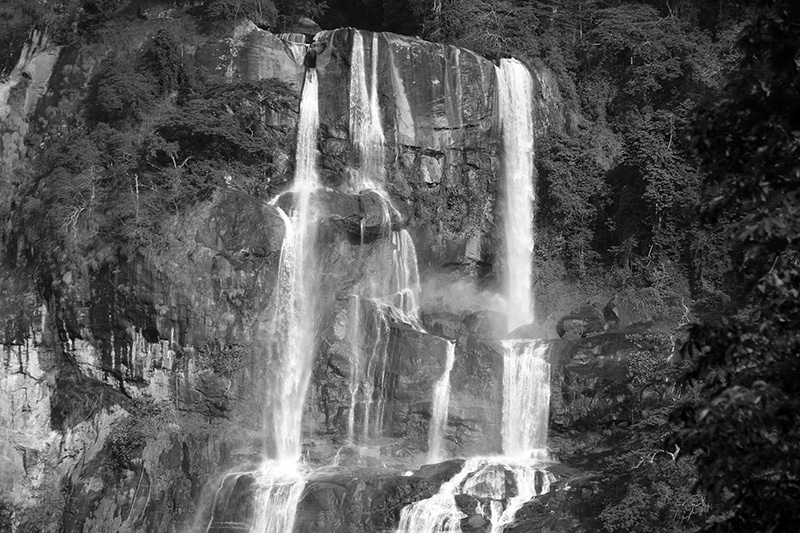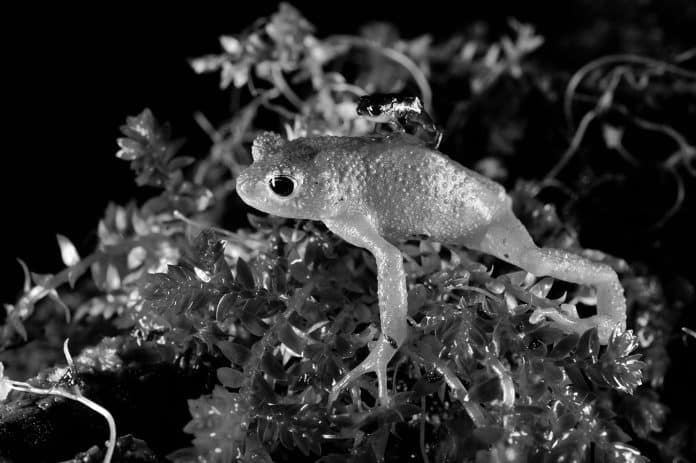Kihansi Spray Toad – Physiology, Habitat, Extinction, Conservation and More
Kihansi Spray Toad Facts
The Kihansi spray toad is a tiny-sized toad found only in Tanzania. The species is insectivorous and live-bearing. Currently, the International Union for Conservation of Nature categorizes the Kihansi spray toad as “extinct in the wild.” This categorization is despite the fact that the toad exists in ex-situ, caged breeding populations.
Physiology
The Kihansi spray toad is a tiny, sexually dimorphic batrachian, with males reaching 0.75 in (1.9cm) long and females reaching 1.1 in (2.9 cm). The toads have yellow skin coloration with brownish strips on the back and sides. The hind legs feature webbed toes without expanded toe tips. They do not have external ears; however, they have typical anuran inner ear characteristics, except for air-filled mid-ear cavities and tympanic membranes. Males usually have more prominent markings, while females have duller colors. In addition, males have dark inguinal spots on the sides where the abdomens intersect with the hind legs. The skin of the abdomen is luminous, and growing offspring can be seen in the tummies of pregnant females. The Kihansi spray toad breeds through internal fertilization, whereby females hold the larvae inside the oviduct till the offspring are birthed.
Habitat
Before its extermination, the Kihansi spray toad used to be endemic to only a 5-acre (two-hectare) area at the base of River Kihansi waterfall in the Udzungwa slope of Tanzania’s the Eastern Arc Mountains. The Kihansi ravine is about 2.5 miles (4 km) long with a north-south orientation. Many wetlands constituted this species’ habitat. Spray from River Kihansi waterfall-fed all these wetlands. The wetlands were characterized by grassy, dense vegetations like snail ferns, Panicum grasses, and Selaginella kraussina. Areas close to the waterfall’s spray zones had 100 percent humidity and nearly constant temperatures. A gravity-fed artificial spray system is currently in place to imitate the spray zones’ original condition. The global range of the species is restricted to the Kihansi Waterfall, which covers less than two hectares, and no extra populations have been found after searching around other parts of the slope of the Udzungwa Mountains.

Extinction in the Wild
Before going into extinction, there were over 16,500 individuals fluctuating naturally. In May 1999, the population peaked but nose-dived to lower numbers in 2001 and 2002. The Kihansi spray toad population peaked once more in June 2003 (more than 20,500) before declining steeply to a point in January 2004 when only three individuals were seen. In May 2009, the species was listed as “extinct in the wild.” The extinction was primarily because of habitat loss after the Kihansi Dam was constructed in 1999. The construction reduced the quantity of water coming down from the fall into the gorge by 80%, greatly reducing the spray volume, especially during the dry season, as well as changing the area’s vegetational composition. This development compromised the spray toad’s microhabitat since it reduced the level of water spray the toads relied on. The spray system that imitated the usual water spray was yet to be operational when the dam opened. A final population crash eventually occurred in 2003. This crash coincided with a collapse of the spray system during the dry season, the temporary opening of the dam to push out sediments that contained pesticides used for cultivating maize, and the occurrence of the disease known as chytridiomycosis. The last verified record of the toads in the wild was in 2004.
Kihansi Spray Toad Conservation Attempts
Environmental Management
From July 2000 to March 2001, gravity-fed artificial spray systems were constructed and positioned in three areas of spray wetlands affected by the construction of the Kihansi Dam. These spray systems imitated the fine water spray that was available before the Kihansi River was diverted, thus, sustaining the microhabitat. Initially, the spray system was successful in sustaining the spray-zone habitat. However, after a year and a half, stream-side plants and the marsh receded, allowing a weedy species to overrun the area, altering the general plant-species composition. The next environmental management steps taken included ecological mitigation, monitoring, creating rights of the water authority, and TANESCO’s implementation of hydrological resources for conserving the spray wetlands and the Kihansi spray toad.
Kihansi Spray Toad Bronx Zoo – Captive Breeding
North American zoos maintain an off-site Kihansi spray toad breeding program in an attempt to reintroduce the species into the wild once again. Bronx Zoo initiated the program in 2001 when more than 450 Kihansi spray toads were removed from their native habitat and placed in 6 American zoos as possible protection against extinction. The unusual reproduction mode and Kihansi Spray toad behavior lifestyle caused problems in captivity initially, and only Toledo Zoo and Bronx Zoo could maintain the toad’s population. Less than 70 remained in captivity by December 2004. However, breeding success and better survival were attained once their exact needs were discovered. Toledo Zoo opened an exhibition for the Kihansi spray toad in November 2005. For some time, the zoo was the only place the toad was publicly on display in the world. The zoo now has Kihansi spray toads in several thousand, the majority of which are off-exhibit. Also, the Bronx Zoo has thousands of Kihansi spray toads; a small exhibit was opened for some of these in February 2010. More than 300 toads were transferred to Warner Park Zoo from Toledo Zoo in 2010. Warner Park Zoo has, in turn, established a small exhibit for them. Groups totaling hundreds are now maintained at Omaha’s Henry Doorly Zoo and Detroit Zoo.
Restoration into the Wild
In 2010, a group of over 75 Kihansi spray toads was flown from the Toledo Zoo and Bronx Zoo to their native habitat in Tanzania as part of the effort to restore the species into the wild, using a propagation center at UDSM. In 2012, scientists from the propagation center returned a test population of 48 toads to the Kihansi slope after finding a way to co-inhabit the spray toads with a substratum assumed to contain chytrid fungus. The substratum was gotten from the Kihansi spray wetlands and mixed with caged toads with the surrogate species from the wild. Reintroduction started because its substratum didn’t seem to house any toxic agents that could threaten the species’ survival. A reintroduction program is expected to be launched in 2017. In the meantime, a few Kihansi spray toads will be successfully restored to their habitat in Tanzania.
In spite of the stringent measures in the breeding facilities, chytrid fungus occasionally attacks the Kihansi spray toads leading to mass deaths at the facility. Malfunctioning water filtration systems and air conditioning have also contributed to the death of the toads. Experts suggest that the restoration of the species to their natural habitat will take some time because it needs to slowly adapt to the wild habitat where it needs to evade Kihansi spray toad predators, overcome disease, and search for food, which is different than the controlled habitat they had during captivity.
For more articles related to Wildlife in Tanzania (Animals), click here!

































